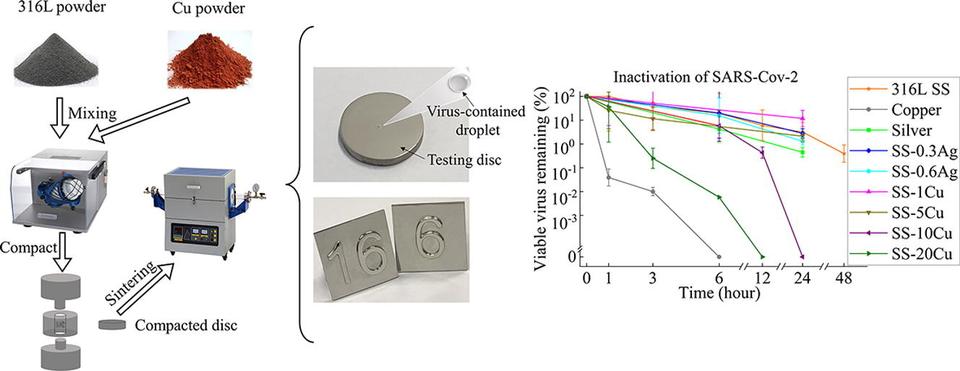The new stainless steel created by Hong Kong scientists, augmented with copper, kills pathogens within hours, showing promise for a future less reliant on constant disinfection or the use of expensive antibacterial and antiviral materials.
In a February 2020 article in the Journal of Hospital Inspection, written in the early days of the pandemic, the authors wrote, “Human coronaviruses can remain infectious on inanimate surfaces at room temperature for up to 9 days … Contamination of frequent touch surfaces in healthcare settings are therefore a potential source of viral transmission.”
And according to a November 2021 article in Chemical Engineering, which heralds a new type of stainless steel, the novel coronavirus “exhibits strong stability on conventional stainless steel (SS) surface, with infectious virus detected even after two days, posing a high risk of virus transmission via surface touching in public areas.”
The authors say while SS products are excellent for corrosion resistance and workability, and thus one of the most frequently touched materials for the public, they do not have antibacterial or antiviral properties on their own.
They add that “the severe acute respiratory syndrome coronavirus 2 (SARS-CoV-2) exhibits strong stability on the surface of conventional SS, with viable virus detected even after three days.”
Researchers in Hong Kong have explored options of keeping frequent-touch surfaces, be they in healthcare settings or high-use areas, free of viral loads. According to a news release, the team of Hong Kong University scientists “has made significant breakthroughs in producing the first anti-pathogen stainless steel that kills the severe acute respiratory syndrome coronavirus 2 (SARS-Cov-2) on its surface.”
The news release introduces the project team as “led by Professor Mingxin HUANG at the Department of Mechanical Engineering of the Faculty of Engineering of the University of Hong Kong (HKU), in collaboration with Professor Leo Lit Man POON’s research team at the Centre for [Immunology] and Infection of HKU.”

Writing in Chemical Engineering, the team say “Antiviral stainless steel inactivates 99.75% of SARS-CoV-2 virus within 3 h.” The steel also has “a long-term anti-pathogen property against SARS-COV-2, H1N1 [swine flu], and E.coli.” They also write that the antiviral stainless steels “can be produced by existing powder metallurgy method.”
The team is exploring mass production options with industrial partners in order to manufacture parts for most-commonly touched surfaces in public areas, “such as lift buttons, doorknobs and handrails.”
The researchers have also tested other elements such as Ag (silver) and Cu (copper) “because of their low toxicity to animal cells and well-known ability to inactivate a broad spectrum of bacteria and viruses.” While pure copper has shown promise, the researchers eliminate it as a viable option because “replacing SS products with pure Cu in public areas is impractical due to its high cost, low strength, and less corrosion-resistant capability.”
The researchers then discuss copper surface coating or ion implantation. They eliminate this option as well because “thickness of coatings is limited … and the damage of coatings on the surface can significantly affect the antimicrobial properties of SS, resulting in a limited service duration.”
Having thus proven the need for a SS to combat the spread of Covid-19, the scientists focus on using powder metallurgy (PM) technology to produce a stainless steel that can inactivate not only bacteria but also viruses.
They conclude that “a low-cost, anti-pathogen Cu-contained stainless steel with long-term anti-SARS-COV-2 properties has been developed successfully,” explaining that “SS [stainless steel] with 20 wt% Cu [copper] can reduce 99.75% and 99.99% of viable SARS-CoV-2 on its surface within 3 and 6 h, respectively.”

Bloomberg notes that “The innovation –– if proved effective and cheaply scalable –– will significantly reduce the costs of regularly disinfecting mass-transit public areas such as airports and train stations as well as other venues where crowds congregate such as movie theaters and sports stadiums.”
As the world prepares for another wave of Covid-19 infections because of the emergence of the Omicron variant, the new stainless steel fortified with copper may help curb infection and allow people a modicum of freedom in these trying times.
Social media is bold.
Social media is young.
Social media raises questions.
Social media is not satisfied with an answer.
Social media looks at the big picture.
Social media is interested in every detail.
social media is curious.
Social media is free.
Social media is irreplaceable.
But never irrelevant.
Social media is you.
(With input from news agency language)
If you like this story, share it with a friend!
We are a non-profit organization. Help us financially to keep our journalism free from government and corporate pressure














0 Comments